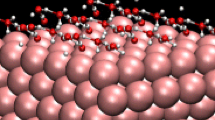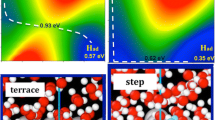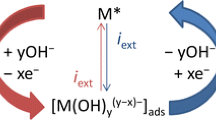Abstract
The adatom/incipient hydrous oxide mediator model for electrocatalysis at a metal/solution interface is outlined in a general manner and examined with particular reference to the behaviour of silver in base. A low level transition, involving less than 0.1% of the surface metal atoms, was observed at ∼0.4 V (RHE). Above this value (where Ag adatoms are assumed to oxidise to hydrous oxide) anodic reactions, e.g. HCHO oxidation or Ag dissolution in the presence of CN−, take place; below this value (where the adatom is unoxidized) cathodic processes, e.g. nitrobenzene or nitrate ion reduction, are catalysed at adatom sites. The role of subsurface oxygen, which may be an inhibiting factor in the case of nitrate reduction, is a feature requiring further investigation.
Similar content being viewed by others
References
L. D. Burke, J. F. Healy, K. J. O'Dwyer and W. A. O'Leary,J. Electrochem. Soc. 136 (1989) 1015.
L. D. Burke and V. J. Cunnane,J. Electroanal. Chem. 210 (1986) 69.
L. D. Burke, M. B. C. Roche and W. A. O'Leary,J. Appl. Electrochem. 18 (1988) 781.
L. D. Burke and W. A. O'Leary,J. Electrochem. Soc. 135 (1988) 1965.
L. D. Burke and K. J. O'Dwyer,Electrochem. Acta 34 (1989) 1659.
L. D. Burke, J. F. O'Sullivan, K. J. O'Dwyer, R. A. Scannell, M. J. G. Ahern and M. M. McCarthy,J. Electrochem. Soc. In press.
L. D. Burke and M. E. G. Lyons, in ‘Modern Aspects of Electrochemistry’ (edited by R. E. White, J. O'M. Bockris and B. E. Conway). Plenum Press, New York (1986) Vol. 18, pp. 169–248.
L. D. Burke, in ‘Electrodes of Conductive Metallic Oxides’, Part A (edited by S. Trasatti), Elsevier, Amsterdam (1980) pp. 141–181.
R. Parsons and T. VanderNoot,J. Electroanal. Chem. 257 (1988) 9.
L. D. Burke and M. B. C. Roche,159 (1983) 89.
L. D. Burke, M. M. McCarthy and M. B. C. Roche,167 (1984) 291.
L. D. Burke and D. P. Whelan,103 (1979) 179.
F. A. Cotton and G. Wilkinson, ‘Advanced Inorganic Chemistry’ (third edition), Interscience Publishers, New York (1972) p. 1047.
L. D. Burke, M. J. Casey, V. J. Cunnane, O. J. Murphy and T. A. M. Twomey,J. Electroanal. Chem. 189 (1985) 353.
C. Nishihara and H. Shindo,202 (1986) 231.
Author information
Authors and Affiliations
Rights and permissions
About this article
Cite this article
Burke, L.D., Ryan, T.G. The adatom/incipient hydrous oxide mediator model for reactions on silver in base. J Appl Electrochem 20, 1053–1058 (1990). https://doi.org/10.1007/BF01019588
Received:
Revised:
Issue Date:
DOI: https://doi.org/10.1007/BF01019588




